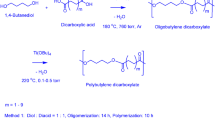Abstract
Vinylidene chloride copolymers have a number of superior properties, most notably, a high barrier to the transport of oxygen and other small molecules. As a consequence, these materials have assumed a position of prominence in the packaging industry. At processing temperatures these copolymers tend to undergo degradative dehydrochlorination. The dehydrochlorination reaction is a typical chain process with distinct initiation, propagation, and termination phases. It has been demonstrated that initiation of degradation is strongly facilitated by the presence of unsaturation along the backbone. Such unsaturation may be introduced via interaction of the polymer with a variety of agents which might commonly be encountered during polymerization or processing. The presence of an unsaturated unit within the polymer generates an allylic dichloromethylene which may function as a major defect (labile) site for the initiation of degradation. The conversion of these dichloromethylene units into non-reactive groups would interrupt propagation of the dehydrochlorination reaction and lead to the stabilization of the copolymer. Potential stabilization in the presence of metal formates has been examined using a vinylidene chloride/methyl acrylate (five mole percent) copolymer and thermogravimetric techniques. The effect of the metal formate on the stability of the polymer reflects the relative halogenophilicity of the metal cation present. Metal formates (sodium, calcium, nickel(II) and to a lesser extent lead(II), cadmium, manganese(II) and magnesium) may be expected to be ineffective as stabilizers for vinylidene chloride copolymers. At the other extreme, metal formates which contain cations sufficiently acidic to actively strip chlorine from the polymer backbone, e.g., zinc formate, will function to enhance the degradation process. An effective carboxylate stabilizer must contain a metal cation sufficiently acidic to interact with allylic chlorine and to facilitate its displacement by the carboxylate anion. Copper(II) formate may possess the balance of cation acidity and carboxylate activity to function as an effective stabilizer for vinylidene chloride copolymers.
Zusammenfassung
Vinylidenchloridkopolymere haben eine Anzahl hervorragender Eigenschaften, am auffallendsten ist der große Widerstand, der dem Transport von Sauerstoff und anderen kleinen Molekülen entgegengesetzt wird. Hieraus ergibt sich die Beliebtheit dieser Materialien in der Verpackungsindustrie. Bei den Fertigungstemperaturen neigen diese Kopolymere zu einer degradativen Dehydrochlorierung. Die Dehydrochlorierung sreaktion ist ein typischer Kettenprozeß mit ausgeprägten Phasen für Kettenstart, Kettenfortpflanzung und Kettenabbruch. Es wurde gezeigt, daß der Abbaubeginn durch die Gegenwart von Ungesättigtheiten entlang der Hauptkette stark erleichtert wird. Derartige Ungesättigtheiten können durch Wechselwirkung des Polymers mit einer Reihe von Stoffen eingebracht werden, die für gewöhnlich während der Polymerisation des Fertigungsprozesses anwesend sind. Die Existenz einer ungesättigten Einheit innerhalb des Polymers bildet ein Allyldichlormethylen, was als eine Hauptdefektstelle zum Abbaubeginn fungieren kann. Die Umwandlung dieser Dichlormethylen-Einheiten in nichtreaktive Gruppen unterbricht die Kettenfortpflanzung der Dehydrochlorierungsreaktion und führt zur Stabilisierung des Kopolymers. Mittels TG wurde eine potentielle Stabilisierung von Vinylidenchlorid/Methylmethacrylat (fünf Molprozent) Kopolymer in Gegenwart von Metallformiaten untersucht. Der Effekt der Metallformiate auf die Stabilität des Polymers widerspiegelt die relative Halogenophilität der anwesenden Metallkationen. Von Metallformiaten (Natrium, Calcium, Nickel(II) und in geringerem Maße Blei(II), Cadmium, Mangan(II) und Magnesium) kann man annehmen, daß sie als Stabilisatoren für Vinylidenkopolymere wirkungslos sind. Im anderen Grenzfalle werden Metallformiate mit Kationen, die genügend sauer sind, um Chlor aktiv von der Polymerhauptkette zu entfernen, wie z.B. Zinkformiat, den Abbauprozeß begünstigen. Ein effektiver Carboxylatstabilisator muß ein Metallion enthalten, welches genügend sauer ist, um mit dem allylischen Chlor in Wechselwirkung zu treten und dessen Ersatz durch ein Carboxylatanion zu erleichtern. Kupfer(II)-formiat hält möglicherweise das Gleichgewicht zwischen Kationacidität und Carboxylataktivität, um als wirkungsvoller Stabilisator für Vinylidenchloridkopolymere zu fungieren.
Similar content being viewed by others
References
G. Strandburg, P. T. DeLassus and B. A. Howell, ‘Barrier Polymers and Structures’, W. J. Koros, Ed. American Chemical Society (Symposium Series No. 423), Washington, D. C., 1990, Ch. 18.
P. T. DeLassus, G. Strandburg and B. A. Howell, Tappi J., 71 (1988) 177.
R. A. Wessling, D. S. Gibbs, P. T. Delassus and B. A. Howell ‘Vinylidene Chloride Polymers’ Encyclopedia of Polymer Science and Engineering, Vol. 17, 2nd Ed. John Wiley and Sons, Inc., New York, NY, 1989. pp. 492–531.
B. A. Howell and P. T. DeLassus, J. Polym. Sci. Polym. Chem. Ed., 25 (1987) 1697
J. D. Danforth, Polym. Prepr. 21 (1980) 140.
J. D. Danforth in P. O. Klemchuk, Ed. ‘Polymer Stabilization and Degradation’, American Chemical Society, Washington, D. C., 1985, Ch. 20.
B. A. Howell, J. Polym. Sci., Chem. Ed., 25 (1987) 1681.
T. Hjertberg, E. Martinsson and E. Sorvik, Macromolecules, 21 (1988) 603.
B. A. Howell and H. Liu, Thermochim. Acta., 212, (1992) 1.
B. A. Howell and P. B. Smith, J. Polym. Sci., Polym. Phys. Ed., 26 (1988) 1287.
A. Ballistreri, S. Foti, P. Maravigna, G. Montando and E. Scamporrino, Polymer, 22 (1981) 131.
W. H. Starnes, Jr. in “Developments in Polymer Degradation-3” N. Grassie, Ed., Applied Science Publishers, Ltd., London, 1981, Ch. 5.
Author information
Authors and Affiliations
Rights and permissions
About this article
Cite this article
Howell, B.A., Rajaram, C.V. Degradation of vinylidene chloride/methyl acrylate copolymers in the presence of metal formates. Journal of Thermal Analysis 40, 575–585 (1993). https://doi.org/10.1007/BF02546627
Published:
Issue Date:
DOI: https://doi.org/10.1007/BF02546627




